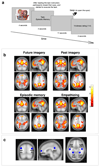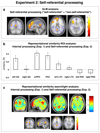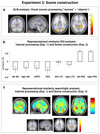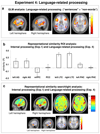The default network and the combination of cognitive processes that mediate self-generated thought
- PMID: 30035236
- PMCID: PMC6054300
- DOI: 10.1038/s41562-017-0244-9
The default network and the combination of cognitive processes that mediate self-generated thought
Abstract
Self-generated cognitions, such as recalling personal memories or empathizing with others, are ubiquitous and essential for our lives. Such internal mental processing is ascribed to the Default Mode Network, a large network of the human brain, though the underlying neural and cognitive mechanisms remain poorly understood. Here, we tested the hypothesis that our mental experience is mediated by a combination of activities of multiple cognitive processes. Our study included four functional MRI experiments with the same participants and a wide range of cognitive tasks, as well as an analytical approach that afforded the identification of cognitive processes during self-generated cognition. We showed that several cognitive processes functioned simultaneously during self-generated mental activity. The processes had specific and localized neural representations, suggesting that they support different aspects of internal processing. Overall, we demonstrate that internally directed experience may be achieved by pooling over multiple cognitive processes.
Keywords: default mode network; fMRI; internal processing; internally directed cognition; mind wandering; self-generated cognition.
Conflict of interest statement
Competing interests: Authors declare no competing financial or non-financial interest.
Figures






References
-
- Smallwood J, Schooler JW. The Science of Mind Wandering: Empirically Navigating the Stream of Consciousness. Annu Rev Psychol. 2015;66:487–518. - PubMed
-
- Killingsworth MA, Gilbert DT. A Wandering Mind Is an Unhappy Mind. Science. 2010;330:932. - PubMed
-
- Smallwood J. Distinguishing how from why the mind wanders: a process–occurrence framework for self-generated mental activity. Psychol Bull. 2013;139:519. - PubMed
Grants and funding
LinkOut - more resources
Full Text Sources
Other Literature Sources

